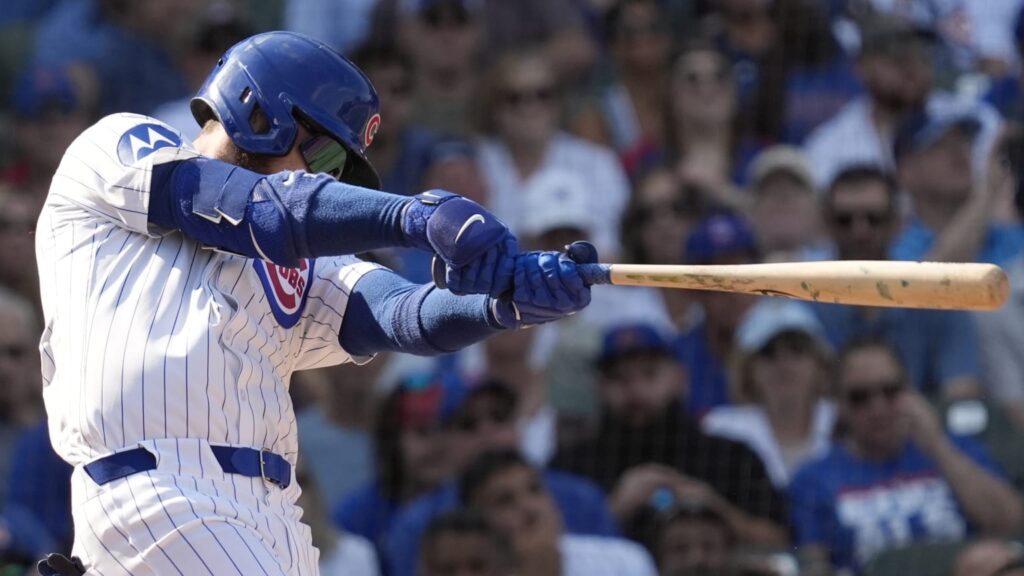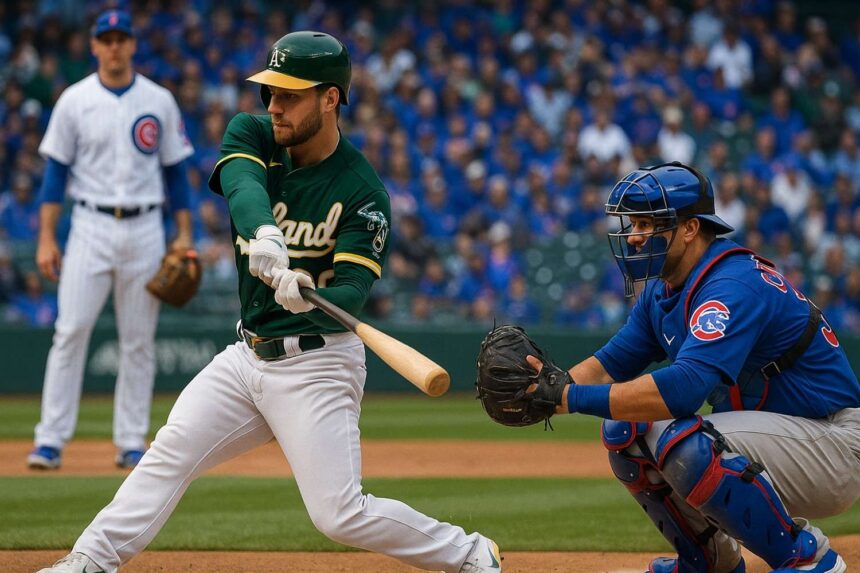The Oakland Athletics vs Chicago Cubs match player stats reveal much about how these two teams compare historically and recently. When you look at head-to-head results, the Cubs have had a clear edge in recent years. In the last 10 meetings, Chicago has won 7 times, often with powerful offensive performances. Oakland, however, has shown some signs of life in a few close games.
One of the most important trends to note is Chicago’s consistency in run production, particularly at home. In games played at Wrigley Field, the Cubs tend to average over 6 runs per game, while Oakland’s average stays below 4 runs. The Cubs also benefit from fewer errors and better bullpen performance in tight matchups.
Here’s a quick head-to-head comparison from the last few games:
| Date | Winner | Score | Home Team | Key Stat |
|---|---|---|---|---|
| Apr 1, 2025 | Cubs | 18–3 | Athletics | Carson Kelly hits for the cycle |
| Apr 2, 2025 | Cubs | 10–2 | Athletics | Suzuki hits HR, 5 RBI |
| Sep 16, 2024 | Cubs | 9–2 | Cubs | Swanson, Tucker go deep |
| Sep 17, 2024 | Cubs | 5–3 | Cubs | Tight bullpen finish |
| Sep 18, 2024 | Athletics | 4–2 | Cubs | Soderstrom 2 RBI win |
As we can see, the Cubs often dominate offensively, but Oakland has managed to steal a few wins when their young hitters perform under pressure. This makes the matchup interesting for fans who enjoy underdog stories or betting on upsets.
Top Performers: Cubs Players vs A’s
The Chicago Cubs have demonstrated their depth and consistency when facing the Oakland Athletics, especially in recent matchups. Several players stand out for their contributions in both batting and pitching, and their names have become regular features in post-game stat sheets. These Cubs players have shown a remarkable ability to exploit weaknesses in the A’s pitching, contributing to Chicago’s dominant record.
Kyle Tucker has been a major force in the lineup since joining the Cubs. In one of the most recent matchups, he recorded 4 hits and 3 RBI, including a home run. What makes Tucker dangerous is not just his power, but also his ability to hit in clutch situations. He had a streak of 4 straight games with a home run, including multiple hits against the A’s bullpen.
Carson Kelly, primarily a catcher, made headlines when he hit for the cycle—a single, double, triple, and home run in the same game—during the 18–3 blowout win over Oakland. That performance included 5 RBI and showcased Kelly’s range as a hitter. Performances like these help the Cubs control momentum early and demoralize opposing pitchers.
Michael Busch also delivered key moments with his 3-for-6 performance and 4 RBI in the same game. Add to that the consistent contributions of Dansby Swanson, Nico Hoerner, and Pete Crow-Armstrong, and the Cubs lineup appears both deep and versatile. These players frequently contribute with multi-hit games and are known for smart baserunning and fielding.
On the mound, Ben Brown played a critical role, pitching 5 innings, allowing 3 earned runs, and striking out 5 batters. He limited damage early and gave the Cubs’ offense time to build a huge lead. Jameson Taillon followed with a 6-inning, 7-strikeout performance in the next game, giving up only 2 earned runs and controlling the tempo throughout.
The following table summarizes key Cubs performances:
| Player | Hits | HRs | RBI | Notable Game Highlight |
|---|---|---|---|---|
| Kyle Tucker | 4 | 1 | 3 | HR in 4 straight games |
| Carson Kelly | 4 | 1 | 5 | Hit for the cycle vs A’s |
| Michael Busch | 3 | 1 | 4 | Multi-RBI performance |
| Dansby Swanson | 2 | – | 1 | Steady shortstop contributions |
| Ben Brown (P) | – | – | – | 5 IP, 3 ER, 5 K vs A’s |
| Jameson Taillon (P) | – | – | – | 6 IP, 2 ER, 7 K, quality start |
In all, these match player stats show the Cubs’ ability to combine explosive offense with solid pitching. Their core hitters are in form, and their pitchers know how to shut down innings when it matters most.
Top Performers: Athletics Players vs Cubs
Despite several tough losses, the Oakland Athletics have a number of young and promising players who have shown potential against the Cubs. While the A’s may not have the same depth or payroll as their opponents, their talent pool is starting to produce results—particularly from emerging hitters and younger pitchers gaining confidence.
Brent Rooker has been one of the few constants in Oakland’s lineup. Known for his raw power, Rooker often hits in the heart of the order and had multiple hits across the recent series. Although he didn’t go yard in the last few games, his on-base percentage and slugging ability still make him a threat every time he steps up.
Jacob Wilson, a rookie, made headlines by hitting his first career MLB home run in a game against the Cubs. This moment was especially exciting for fans hoping for a fresh start, as Wilson showed excellent bat speed and situational awareness.
JJ Bleday and Tyler Soderstrom also stood out. Bleday had several hits in the series and showed great plate discipline, while Soderstrom drove in 2 RBI in the A’s lone win over the Cubs last September. These stats, though less eye-popping than the Cubs’ stars, reflect gradual development in Oakland’s rebuilding phase.
In terms of pitching, Joey Estes showed promise with his control early in games, but he struggled once hitters adjusted. His line included 4.1 IP, 6 earned runs, and 4 walks. On the other hand, Mitch Spence and JP Sears have had better outings in other series, hinting at the rotation’s long-term potential.
A look at the A’s performers:
| Player | Hits | HRs | RBI | Notable Game Highlight |
|---|---|---|---|---|
| Brent Rooker | 2 | 0 | 1 | Consistent contact hitting |
| Jacob Wilson | 1 | 1 | 1 | First MLB HR vs Cubs |
| JJ Bleday | 2 | – | – | Multi-hit game |
| Tyler Soderstrom | 1 | – | 2 | Game-winning RBIs in previous matchup |
| Joey Estes (P) | – | – | – | 4.1 IP, 6 ER, struggled vs Cubs |
Though the Athletics are clearly in a transition period, their match player stats show that young talent is coming through. The question is how quickly that talent can develop into consistent, game-winning production.
Batting Breakdown: OPS, Slugging & Average Comparisons
When comparing the Oakland Athletics vs Chicago Cubs match player stats, the batting numbers clearly show which team holds the upper hand offensively. From on-base plus slugging percentage (OPS) to batting averages and home run power, the Cubs outpace the Athletics across the board. These stats help paint a clear picture of where each team stands and what gaps remain for Oakland to close.
The Cubs’ team OPS during their most recent series against the A’s hovered around .920, which is considered elite. They combined power hitting with high on-base ability, thanks to players like Kyle Tucker, Seiya Suzuki, and Michael Busch. In the 18–3 blowout, Chicago recorded over 20 hits, including 4 home runs, demonstrating how deep their lineup runs. Even bench players contributed with base knocks and RBIs.
The Athletics, on the other hand, posted a team OPS of around .630 in the same series—significantly below the league average. Although Jacob Wilson’s solo homer and Soderstrom’s clutch hits offered sparks, there was a clear lack of sustained offense. Oakland hitters struggled with runners in scoring position (RISP), often failing to capitalize on rare scoring opportunities.
Let’s look at a batting stat comparison from the last 3 games:
| Stat | Cubs | Athletics |
|---|---|---|
| Team Batting Avg. | .355 | .221 |
| Team OPS | .920 | .630 |
| Home Runs | 6 | 2 |
| Extra-Base Hits | 12 | 4 |
| Runners LOB | 17 | 24 |
Slugging percentage is another major gap between the teams. The Cubs often turn singles into doubles and aren’t afraid to swing for the fences with runners on base. This makes them especially dangerous in hitter-friendly parks. The Athletics, however, lean on contact hitting, which has not been enough to keep pace against elite pitching.
Strikeout rate is also worth mentioning. Oakland hitters struck out nearly 10 times per game in this series, while the Cubs managed to keep their strikeouts low and walks high. This kind of plate discipline is what leads to productive innings and rallies.
In short, the Cubs’ batting stats show a team in rhythm and filled with power threats, while Oakland’s numbers highlight a lineup still searching for consistency and clutch execution.
Pitching Showdown: ERA, Strikeouts, Bullpen Impact
Pitching plays a central role in any baseball matchup, and in the case of Oakland Athletics vs Chicago Cubs match player stats, the contrast is stark. The Cubs have had the luxury of reliable starters and a confident bullpen, while the Athletics are still building consistency across their rotation.
ERA (Earned Run Average) is one of the clearest indicators of pitching effectiveness. In their recent series, the Cubs’ starting pitchers posted an average ERA of just 2.67, while Athletics starters had a combined ERA above 7.00. This discrepancy alone explains much of the Cubs’ scoring advantage.

Shota Imanaga, although not pitching in the most recent games, has been one of the season’s most dominant pitchers, averaging over 10 strikeouts per 9 innings. Jameson Taillon added to the pitching strength with his 6-inning, 7-strikeout performance, keeping the A’s off balance with a mix of high fastballs and curveballs. Ben Brown also delivered a solid outing, giving up 3 runs over 5 innings while inducing several groundouts.
In contrast, Joey Estes and JP Sears for Oakland struggled early in counts and allowed too many baserunners. Estes in particular surrendered 6 earned runs in just over 4 innings, while walking 4 batters—evidence of poor control and command.
The bullpen stats show another advantage for the Cubs. Their relievers, including Mark Leiter Jr. and Julian Merryweather, combined for zero earned runs over 6 innings of relief in the series. Oakland’s bullpen, however, gave up multiple insurance runs, eliminating any chance of a comeback.
Here’s a snapshot of the pitching stats:
| Stat | Cubs | Athletics |
|---|---|---|
| Avg. ERA | 2.67 | 7.11 |
| Avg. Strikeouts (9 IP) | 9.8 | 6.3 |
| Bullpen ERA | 0.00 | 4.87 |
| Walks Allowed (Series) | 6 | 12 |
| Home Runs Allowed | 1 | 6 |
The numbers don’t lie—the Cubs dominate the mound with better velocity, control, and game management. The A’s need more stability from their starters and more bite from their bullpen if they want to reverse this matchup trend.
Highlighted Player Profiles
To fully understand the Oakland Athletics vs Chicago Cubs match player stats, it’s helpful to look at standout individuals who have shaped recent outcomes. These players not only represent current team strengths but also signal where future performance may be heading. From consistent stars to emerging prospects, both sides have players worth spotlighting.
Kyle Tucker – Cubs Outfielder
Tucker has been a game-changer since joining the Cubs. In the series against Oakland, he recorded a 4-hit game, drove in 3 runs, and hit a home run—part of a hot streak where he went deep in four consecutive games. Known for his balanced approach at the plate and excellent pitch recognition, Tucker brings power and poise, especially in high-leverage moments. His defense in right field has also helped prevent extra-base hits, contributing to Chicago’s overall run suppression.
Carson Kelly – Cubs Catcher
Kelly’s most memorable moment came during the Cubs’ 18–3 win, when he hit for the cycle—a rare feat that includes a single, double, triple, and home run in one game. He also posted 5 RBI and controlled the tempo behind the plate. His ability to manage pitchers and deliver clutch offense makes him a dual-threat and one of the Cubs’ most valuable assets in the series.
Nico Hoerner – Cubs Infielder
Hoerner consistently contributes on both ends of the field. With his Gold Glove defense, speed on the bases, and high-contact approach, he’s the kind of player who keeps innings alive and frustrates pitchers. He had multiple hits and scored runs in almost every game of the series, often turning small opportunities into big momentum shifts.
Jacob Wilson – Athletics Rookie Infielder
For the Athletics, Jacob Wilson was a bright spot. He hit his first MLB home run against the Cubs, a solo shot that gave Oakland some hope during a lopsided game. Wilson showed good mechanics at the plate and a mature batting eye, despite being new to the majors. If developed properly, he could become a cornerstone of the A’s rebuild.
Tyler Soderstrom – Athletics Catcher
Soderstrom contributed 2 RBI in the A’s lone recent win over the Cubs. A powerful left-handed bat, he has shown flashes of future stardom with quick hands and gap-to-gap power. His offensive contributions have been especially important given Oakland’s broader struggles at the plate.
Joey Estes – Athletics Starting Pitcher
Although Estes struggled with command, he showed moments of potential. His fastball touched the mid-90s, and his breaking ball had good shape when located well. However, his line of 4.1 innings, 6 earned runs, and 4 walks underscores the need for refinement and consistency.
These individual match player stats highlight why the Cubs dominate this matchup but also show glimpses of hope for Oakland if their young talent continues to develop. It’s not just about who’s hot today, but who could be dangerous tomorrow.
Game Highlights & Recent Match Recaps
The recent meetings between the Oakland Athletics and Chicago Cubs have been a showcase of explosive offense, strong pitching, and key momentum swings. Let’s revisit the three-game stretch that shaped their current narrative and created headline-grabbing match player stats.
Game 1 – Cubs 18, Athletics 3
This was a complete blowout from the start. The Cubs jumped out to an early lead with Carson Kelly’s cycle and Michael Busch’s 4 RBI performance. Kyle Tucker added a solo homer, and every Cubs starter reached base at least once. Ben Brown pitched 5 effective innings, allowing just 3 earned runs while striking out 5.
“It was one of those nights where everything clicked,” said Cubs manager Craig Counsell after the game.
Game 2 – Cubs 10, Athletics 2
Jameson Taillon took control on the mound with 7 strikeouts and just 2 earned runs over 6 innings. The offense was led by Seiya Suzuki, who hit a 3-run homer and drove in 5 runs total. Kyle Tucker continued his power surge, hitting another home run, and the Cubs’ bullpen shut down any chance of an A’s comeback.
“They’re aggressive early in the count,” Athletics pitcher Joey Estes said postgame. “And they don’t miss mistakes.”
Game 3 – Athletics 4, Cubs 2
This was a surprising and much-needed win for Oakland. Tyler Soderstrom drove in 2 crucial runs, and the A’s bullpen managed to hold off the Cubs’ hitters in the late innings. Jacob Wilson’s first MLB home run gave the team an early lead, and for once, the Cubs were the ones playing catch-up. The Athletics’ ability to finally capitalize on scoring chances was the difference-maker.
Here’s a summary of the three-game series:
| Game Date | Result | Key Performers | Notable Stats |
|---|---|---|---|
| April 1, 2025 | Cubs 18–3 | Kelly, Tucker, Busch, Brown | Cubs: 20 hits, Kelly hit for cycle |
| April 2, 2025 | Cubs 10–2 | Suzuki, Tucker, Taillon | Cubs: 4 HRs, Taillon 7 Ks |
| April 3, 2025 | Athletics 4–2 | Soderstrom, Wilson, bullpen unit | Wilson’s first HR, bullpen shutout |
These games highlight the disparity in depth and execution between the two teams. But they also underscore how a few standout moments can shift momentum—even in seemingly one-sided matchups.
What the Stats Reveal: Trends, Insights & Predictions
Looking beyond the raw numbers, the Oakland Athletics vs Chicago Cubs match player stats uncover deeper insights about each team’s trajectory, strengths, and areas that need improvement. These aren’t just isolated performances—they form part of larger patterns that can inform predictions about future matchups.
Trends That Favor the Cubs
The Cubs have consistently demonstrated that they are built for both short-term wins and long-term consistency. With veterans like Dansby Swanson and Kyle Tucker leading the lineup and young players such as Michael Busch and Pete Crow-Armstrong making their mark, the team has found a balanced core. Chicago’s ability to get early leads and then allow its bullpen to shut down games has been central to their success.
Another notable trend is their plate discipline. While the A’s chase pitches outside the zone, the Cubs walk at a higher rate and strike out less often. Over time, this means more baserunners, more runs, and more pressure on opposing pitchers. In recent games, Cubs hitters averaged 6.3 walks per game, while Athletics hitters averaged just 2.1.
Their pitchers, particularly in the bullpen, are also peaking. The combination of low walk rates, high strikeout totals, and strong pitch location make them difficult to score against in late innings. This pitching reliability, combined with offensive consistency, makes the Cubs a top-tier team in this matchup.
A’s Rebuilding and Inconsistency
The Athletics are clearly in a rebuilding phase. The match stats against the Cubs show flashes of potential—Jacob Wilson’s HR, Soderstrom’s clutch RBIs, Brent Rooker’s patient at-bats—but not enough consistency to win tight games. One concerning pattern is the A’s tendency to strand runners on base. In three games, they left 24 runners stranded, showing missed opportunities.
The A’s starting pitchers are often pulled before the 5th inning due to high pitch counts and poor control. Without starters who can eat innings and reduce the load on the bullpen, Oakland’s relievers are stretched thin by the third game in a series.
Still, the future holds promise. Players like JJ Bleday, Zack Gelof, and Tyler Soderstrom have the tools to develop into elite hitters. With more experience, these young stars could close the gap in upcoming seasons.
Predictions for Future Matchups
If the current trends hold, the Cubs are likely to continue dominating this matchup, especially in high-stakes series or playoff contexts. Their depth, discipline, and pitching control give them a significant edge. However, if Oakland’s young core matures quickly and the front office adds a few veteran arms, the balance could shift over the next couple of seasons.
Key Predictions:
- Cubs will likely win 70–80% of matchups over the next season, barring major injuries.
- Athletics may see increased run production in home games by late season 2025 as rookies adjust to MLB pitching.
- Pitching remains the A’s biggest obstacle, especially in games decided after the 6th inning.
This kind of trend analysis shows that while the Cubs currently dominate the Oakland Athletics vs Chicago Cubs match player stats, baseball remains a game of change. Momentum can shift fast—and new stars may soon emerge.
FAQs
1. Who has the better player stats between Cubs and A’s?
The Cubs have stronger player stats overall in both hitting and pitching categories.
2. What was the highest-scoring game recently?
Cubs won 18–3 on April 1, 2025, with Carson Kelly hitting for the cycle.
3. Who hit the most home runs in the series?
Kyle Tucker hit home runs in four straight games, leading the power numbers.
4. Did any Athletics player shine in the series?
Yes, Jacob Wilson hit his first MLB home run and Soderstrom had 2 clutch RBIs.
5. What’s the Cubs’ win percentage vs the A’s recently?
In their last 10 matchups, the Cubs have won about 70% of the games.
Further Resources & Authority Links
If you’re interested in diving deeper into the Oakland Athletics vs Chicago Cubs match player stats, here are some valuable resources:
- Baseball-Reference Box Scores – Full stat logs and advanced metrics
- StatMuse H2H History – Quick head-to-head stat comparisons
- MLB.com Player Profiles – Individual player breakdowns
- CBS Sports Game Recaps – Match recaps and key stats
- Blookethost Blog Analysis – In-depth fan-focused breakdowns






